Fifth Street is a census Designated Place and unincorporated area in Fort Bend County, Texas. It is in the eastern portion of the county and on the border of Southwest Houston.
Portions of the area are in Stafford and Missouri City. The selected pages below are from the Stafford Historical Society’s book about the city, included the formerly, predominately Black and Latino, Fifth Street area.
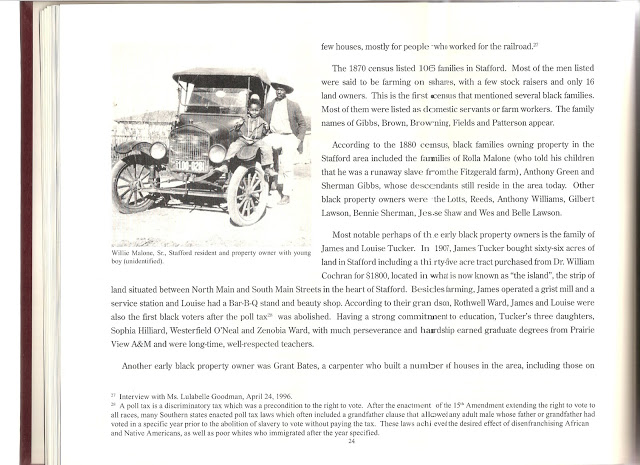
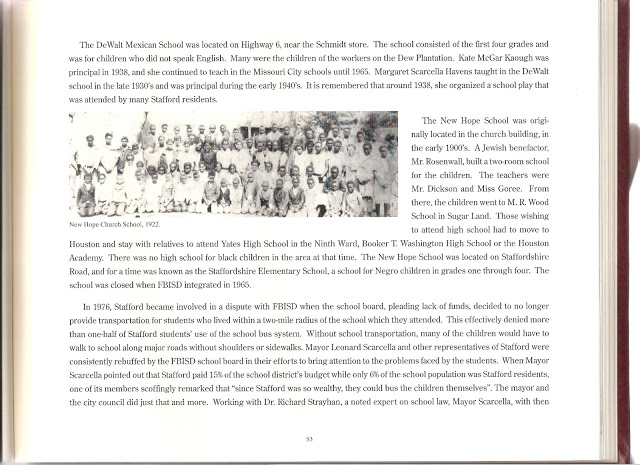

I invite residents to upload their own pictures and stories about Fifth Street.
More about the cemetery posted above:
Though originally known as the Gibbs Cemetery, the Farmers Improvement Society (FIS) Cemetery was founded by the Morning Star Branch No.358 in 1912. The FIS began collecting dues meant for death benefits as early as 1910. The Cemetery located on 5thStreet near Stafford, Texas in east Fort Bend County, has also been known as the New Hope Cemetery and the Stafford Colored Cemetery. The Gibbs family owned the land on which the cemetery now sits. Sherman Gibbs purchased 40 acres of the David Bright League, which he then took a portion of to dedicate for the family cemetery. These 40 acres were of 160 acres of land purchased from Amanda Cartwright in 1891 by four formerly enslaved Africans. The Gibbs family was one of several African American landowners listed in the 1870s US census of Stafford, Texas.
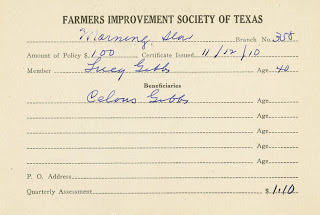 Lucy Gibbs and her husband sold the cemetery land to Farmers Improvement Society leaders who served as cemetery trustees. These cemetery trustees included the Tuckers who were one of many Blacks land owners in the area that were later interred in the FIS Cemetery on Fifth Street in Fort Bend County, near Stafford. The original trustees were the William and Lucy Gibbs, James Washington, JB Malone, and James Tucker.
Lucy Gibbs and her husband sold the cemetery land to Farmers Improvement Society leaders who served as cemetery trustees. These cemetery trustees included the Tuckers who were one of many Blacks land owners in the area that were later interred in the FIS Cemetery on Fifth Street in Fort Bend County, near Stafford. The original trustees were the William and Lucy Gibbs, James Washington, JB Malone, and James Tucker.
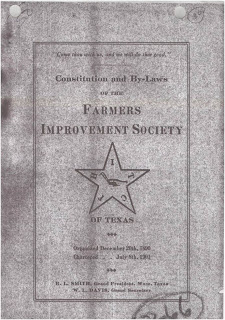 The FIS managed the cemetery as of 1912. The organizations bylaws referred to the group as “The Best Poor Man’s Society on Earth”. According to the Handbook of Texas Online, Robert Lloyd Smith of Oakland, Colorado County founded the FIS as a farmers’ association for African Americans in1890. The purposes of the society were to abolish the share-cropping and credit system that ensnared poor farmers, encourage self-sufficiency, promote home and farm ownership, promote crop diversification and use of improved farming methods, foster cooperative buying and selling, provide sickness and health benefits, and encourage the social and moral elevation of members.
The FIS managed the cemetery as of 1912. The organizations bylaws referred to the group as “The Best Poor Man’s Society on Earth”. According to the Handbook of Texas Online, Robert Lloyd Smith of Oakland, Colorado County founded the FIS as a farmers’ association for African Americans in1890. The purposes of the society were to abolish the share-cropping and credit system that ensnared poor farmers, encourage self-sufficiency, promote home and farm ownership, promote crop diversification and use of improved farming methods, foster cooperative buying and selling, provide sickness and health benefits, and encourage the social and moral elevation of members.

By 1909, the FIS had 21,000 members in Texas, Oklahoma, and Arkansas. Members founded an Agricultural College and Farmers’ Bank at Waco in 1911 While the organization declined by the 1940s, the local FIS Cemetery trustees’ descendants maintained the cemetery as it changes from the FIS to the Stafford Colored Cemetery in 1954.
Founders of the FIS chapter are interred along with a large contingent of African American veterans who have served in WWI, WWII, the Korean War, and the Vietnam War. James Tucker was a cemetery trustee and member in good standing who is buried in the FIS. The Tuckers were the first to vote after the poll tax was abolished in the County. His daughter, interred at the FIS cemetery on Fifth Street, was Westerfield Tucker O’Neal, a teacher and university administrator at Prairie View A&M.
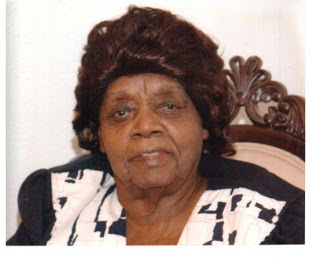 Other prominent African American landowners interred at the Cemetery include the Malones, Browns, Fields, and Shaws. The Shaws were descendants of the legendary barrelhouse piano legend, Robert Shaw recognized by the State Senate for his contribution to the state’s musical heritage.
Other prominent African American landowners interred at the Cemetery include the Malones, Browns, Fields, and Shaws. The Shaws were descendants of the legendary barrelhouse piano legend, Robert Shaw recognized by the State Senate for his contribution to the state’s musical heritage.
The FIS cemetery represents one of the few remaining pieces of evidence of the thriving African American settlement in the area. This cemetery is one of the few remnants of Booker T Washington’s national self-help, uplift movement in Texas. Supported by the dues of the FIS, widowed chicken farmers, sharecroppers, educators, Imperial Sugar Refinery employees, and ministers were all buried with dignity many of whom were born shortly before slavery ended in Texas.
The Cemetery is still active. While the FIS collected sick and burial benefits dues from membership, the national organization disbanded in the late 1930s. The association then led to the passing of the cemetery management over to trustees who were descendants of the original founders. These individuals then formed an ad hoc association, which managed what was named the Stafford Colored Cemetery in 1954.
In 1969, the FIS committee president was Andrew Wright, secretary was Julia Lathan, and treasurer was Clinton Trimble. Dues were custom paid every Memorial Day. In 1995, Tom Minter, Jr. purchased a survey of cemetery site A 2.421 acre tract William Neal Survey, A-64 Fort Bend County, Texas. In 1998, the president was Tom Minter, Jr., secretary was Yvette Logeman, and treasurer was Rutha Pickett. In 2005, Tom Minter, Jr.’s daughter, Eunice Jackson, became the president and still holds the position.
Bibliography
Robert Carroll, Robert Lloyd Smith and the Farmers’ Improvement Society of Texas (M.A. thesis, Baylor University, 1974).
Fort Bend County Clerk Deeds, 1912, 1954.
R L Smith, “Constitution and By Laws of the Farmers’ Improvement Society of Texas”, 1896, Briscoe Center for American History TXC-XZ Collection.
Morning Star Branch No. 358, FIS Membership Card for James and Louise Tucker, 1912, The Texas Collection, Baylor University, requested 4/25/12.
Stafford Historical Society History